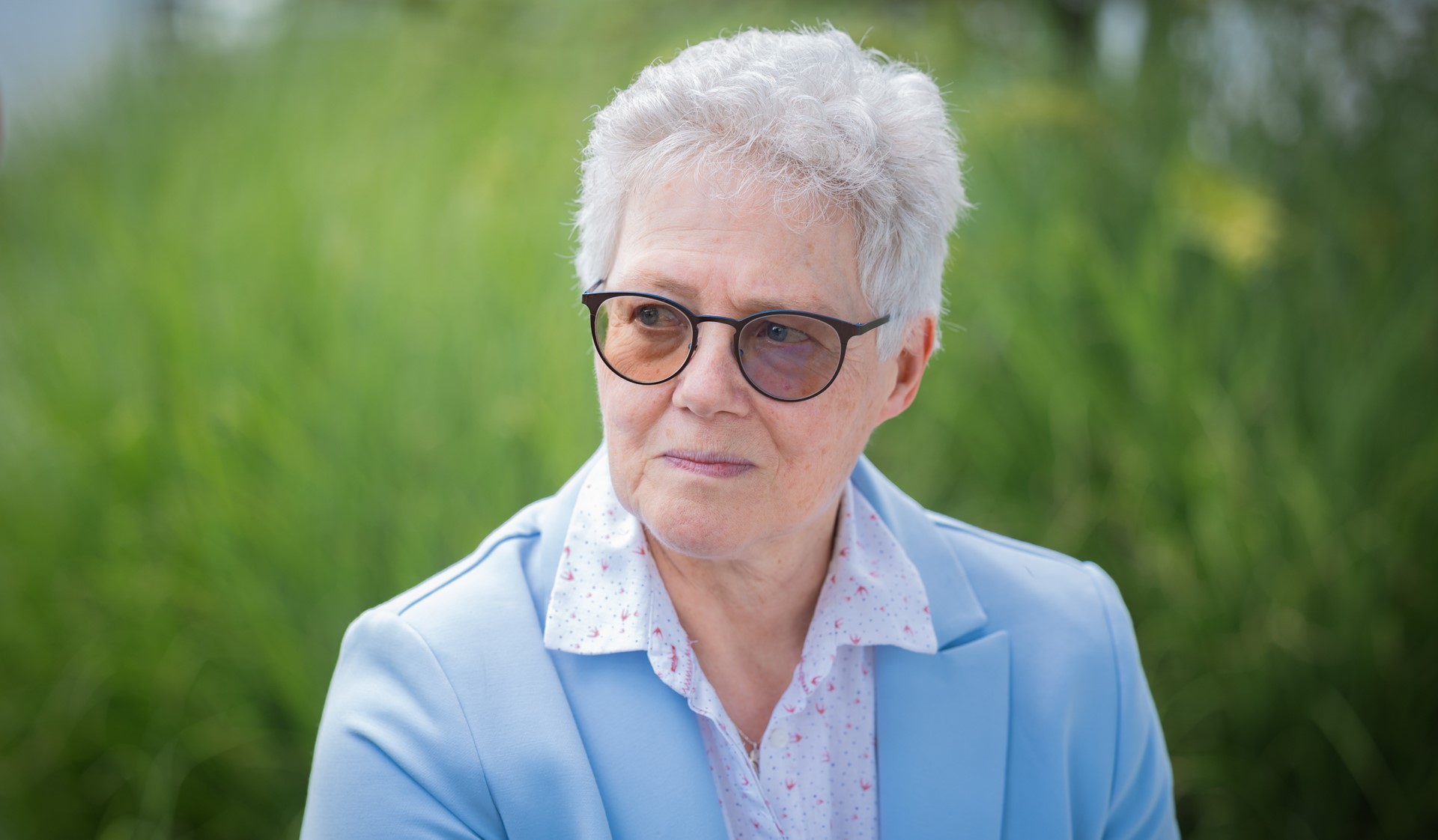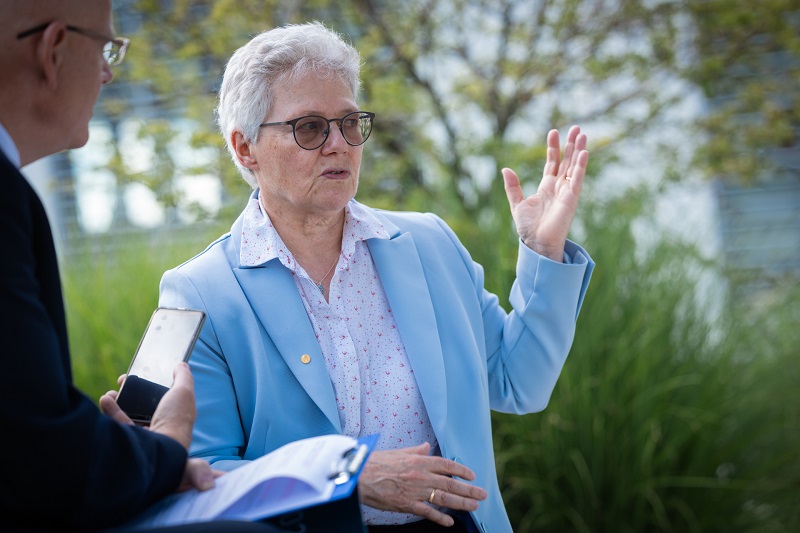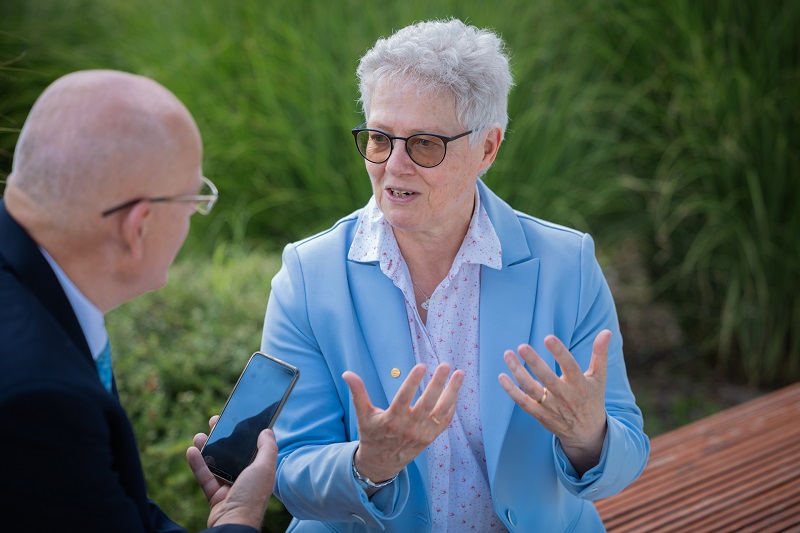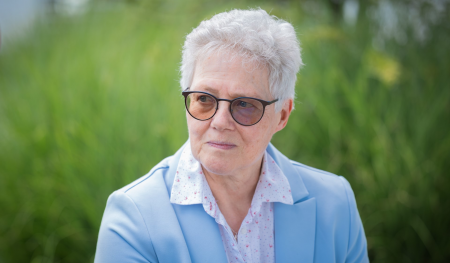
At the invitation of the University of Szeged and the ELI ALPS Laser Research Center, the French/Swedish Nobel Prize-winning physicist Anne L'Huillier visited Szeged. The name of the Lund University professor, together with the other two Nobel Prize-winning researchers of attosecond physics, Pierre Agostini and Ferenc Krausz, is preserved by a science history landmark on the way to the ELI ALPS. Anne L'Huillier carried out the experiment that led to today's attosecond physics at a young age, just after her doctoral thesis.
– Professor, you are only the fifth woman to win the Nobel Prize in physics, and the second Frenchwoman after Marie Curie. What led you as a young researcher to nuclear physics? In the 1980s, it must have been unusual for a young woman to start working at the Commission for Atomic Energy, at the Paris-Saclay research center.
– This happened much more simply than you think: I had excellent physics and mathematics teachers at the high school, and excellent teachers at the university also turned my attention to atomic physics. It may sound banal, but everything went its way. I was interested in science from a very young age, and as I progressed, the opportunities presented themselves. This is how I got to the point where I could work on a doctoral topic in nuclear physics related to lasers at the Paris-Saclay research institute.
– You are both a theoretical and an experimental physicist and even a mathematician and a physicist at the same time. Which do you consider to be your true character?
– I obtained a double degree in mathematics and physics, I chose physics in my last year of university. I have always considered it important to have the abstract methods of mathematics, which helps to understand the phenomena studied in experiments. I also tried to combine the two whenever possible, because it gave me the freedom to interpret the experimental results myself. At the same time, I still wanted to prepare a doctoral thesis in experimental physics, since for me the research of physical phenomena takes place in a laboratory and is of an experimental nature.
– One year after your doctoral thesis, during an experiment you discovered the phenomenon that led to today's attosecond physics. Was the appearance of high harmonics a complete surprise to you?
– In 1986, I completed my doctoral thesis on multiphoton multiple ionization, and in the summer of 1987, I received an offer from the Paris-Saclay research center, where we also investigated this phenomenon experimentally. With the help of a high-intensity laser, we used the simultaneous absorption of several photons to break electrons from the attraction of the atomic nucleus. Based on my thesis and other studies, the idea was developed at that time that an atom can not only be ionized but the electrons in it can be moved toward excited states. Upon de-excitation, the atom emits light, which we call fluorescent light. So the idea was to probe this light to learn more about excitation by absorption of intense laser radiation. This was a fairly obvious idea. However, it still amazes me that we saw something completely new. In the light detected in the direction of laser propagation, there were many high harmonic components. Harmonics means that their frequency is equal to an integer multiple of the frequency of the initial laser light. It was even more surprising that we would have expected their intensity to decrease as we moved toward higher and higher-order harmonics, but instead, we saw a plateau of constant intensity. That is, the high harmonics had almost the same intensity up to a certain cut-off frequency. It was a memorable experimental discovery. It completely determined my future career. Based on this experience, I decided to continue research in this area, and I still do so today.

French/Swedish Nobel Prize-winning physicist Anne L'Huillier. Photo: Ádám Kovács-Jerney
– Today, few phenomena are encountered by experimental physicists that are not predicted by computer simulations. How was it back then?
– There were simulations of related phenomena, however, the appearance of high harmonics was a phenomenon that researchers had not yet dealt with much at the time. After observing the phenomenon, it took a long time to interpret it: at first, we tried a perturbation calculation, from which it would have followed that the higher the harmonic, the weaker the signal must be. And we experienced the opposite, an intensity plateau. It was really surprising and a real discovery for us.
– What was your experimental equipment like in 1987?
– At that time, we worked with a rather rudimentary Yag laser with a picosecond pulse, because there was no femtosecond laser yet. We had an interaction chamber with old oil diffusion vacuum pumps. It was really old-fashioned equipment. After the discovery, it became crucial to advance laser technology and a major role was played by the 1986 laser amplification achievement of Gérard Mourou and Donna Strickland, which led to the creation of a higher intensity femtosecond laser by 1992. Immediately after the phenomenon was detected, the question arose: can we produce extremely short light pulses if the high harmonics that are formed add up constructively? At the end of the 1990s, the theoreticians' answer was that it is possible to coordinate the phase of the harmonics, and at the beginning of the 2000s, Pierre Agostini gave an experimental method for measuring attosecond pulse sequences and Ferenc Krausz for individual attosecond pulses.
– Your discovery in 1987 led to a completely new physics. Do you think that similar paths can still be opened in physics?
– I am quite sure of that. There is still much to discover in many areas of physics. Whichever direction we take, there is much to understand. There are many discoveries to be made in atomic physics, quantum physics, condensed matter physics, or cosmology. The areas may be ones that we aren't aware of today. After all, who talked about attosecond science before our experiment in 1987?! Therein lies the power of an experimental discovery!

Photo: Ádám Kovács-Jerney
– What do you think is the most important challenge for attosecond physics in the next period?
– I think it is to justify the value of the usability of our completed devices and of attosecond pulses in general. In a sense, the Nobel Prize for the research expressed the hope that this field would lead to practical results for the benefit of humanity as a whole, in particular by better understanding the dynamics of electrons in complex matter. Previously, we performed demonstration experiments on atoms; now it will be possible to observe the movement of electrons in more complex systems, such as molecules, during chemical reactions.
– What do you expect to be its most important application in the future?
– I think it will be an application developed for the semiconductor industry: extreme ultraviolet lithography (EUVL) technology is set to revolutionize chip manufacturing. In this technology, a high-intensity laser is used to create plasma on the surface of tiny tin droplets to generate the EUV light used for the lithography of semiconductor silicon wafers. This application is already under development and I hope to hear of other similar applications in the not-too-distant future.
– Your university research group in Lund cooperates with researchers from SZTE and ELI ALPS. What has been your biggest success so far?
– For me, the great success is that the lasers of the ELI ALPS research center have outstanding parameters. These are the most advanced lasers in the field, producing world-class attosecond beamlines that combine our current state-of-the-art photonics knowledge. Personally, I expect the advancement of attosecond physics to come not from researchers working on fundamental phenomena, but from physicists working on practical applications. That is why it is extremely important that the ELI ALPS beamlines and facilities are open to user researchers.

Photo: Ádám Kovács-Jerney
– Among the ELI ALPS beamlines, the SYLOS GHHG Long beamline was designed by your research group. It is said to be unique in the world in that a mirror with a focal length of up to 55 meters can be used to produce attosecond pulses.
– The SYLOS GHHG Long beamline is used to produce high-intensity attosecond pulses. The basic phenomenon here too is that we direct ultrashort laser pulses into a gas beam, where the interaction of individual gas atoms and the laser pulse creates high harmonics. Attosecond light pulses are obtained by phase matching the elementary waves emitted by individual atoms. The novelty is that due to the larger focal length than usual, the focal spot of the laser will be larger, and the interaction of the gas atoms and the laser light will take place in this larger area. ELI ALPS has lasers with sufficiently high pulse energy, and their energy can be used more efficiently to generate attosecond pulse trains with a higher number of photons and higher intensity.
– The Swedish press called you the paparazzi of infinitesimal phenomena. Or, like Katalin Karikó, do you feel like Lieutenant Columbo, who always has one more question?
– The press was suggesting that attosecond light pulses, like a photographic device with a very short flash time, can be used to study extremely fast electron movements within matter. I also followed the Columbo film series, I had fun with it, and I agree with Katalin Karikó, there is indeed something in common with the research work, the way Columbo always comes back and asks one more question because he has to understand the problem. Understanding a phenomenon is like a puzzle, each piece of which is important, but only the whole picture will show what happened in the experiment. That is why I would say persistence is one of the most important research virtues; you must consistently continue working on a problem, and you must not give up.
– You recently spoke to Radio France Culture about writing a book. On the road to the Nobel Prize, like Katalin Karikó?
– Oh, I'm not writing a book for the general public, my book will be for physics students. For students, I would summarise the physics of harmonics and attosecond pulses, which I have studied in detail for almost forty years.
Written by Sándor Panek
Featured image: French/Swedish Nobel Prize-winning physicist Anne L'Huillier.
Photo by Ádám Kovács-Jerney

